Oregano: Health Benefits, Uses, And Side Effects
Cause this aromatic herb is not merely a pizza seasoning – it is great for your health too!
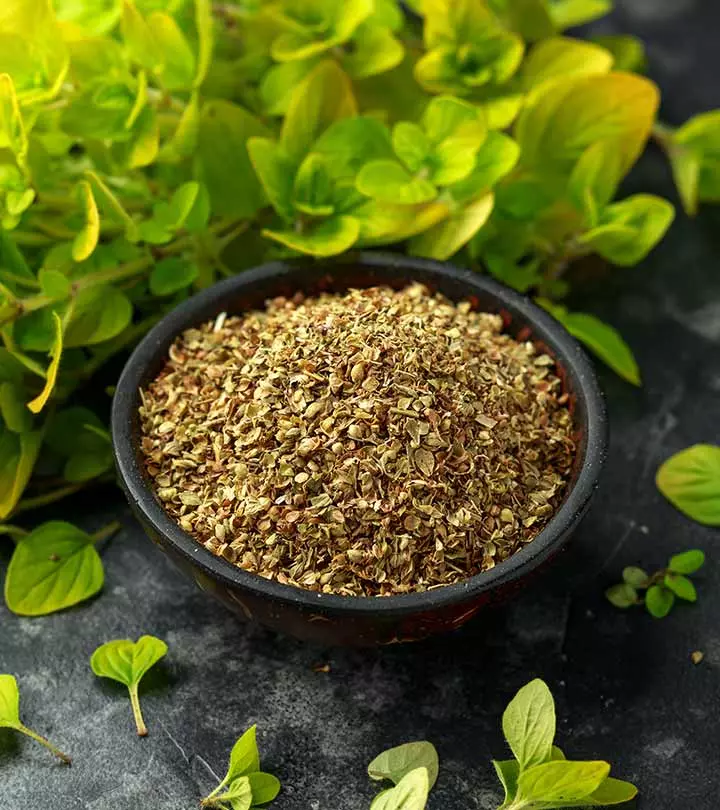
Image: Shutterstock
Most of us know oregano as a pizza seasoning. But do you know it has many medicinal properties too? Oregano benefits you in multiple ways. The extracts of oregano leaves were used by Greeks for pain relief and to combat microbial infections, and treat menstruation issues. It is a regular ingredient in Mediterranean cuisine (1).

Recent research has proven that oregano contains polyphenolsi Plant compounds believed to improve digestion and brain health and guard against heart disease, type 2 diabetes, and certain cancers. (1). These polyphenols benefit your skin and hair in multiple ways.
In this article, you will read more about this spicy herb, the benefits it offers, how to cook it, and ways to store it.
Continue reading to know more.
 Know Your Ingredient: Oregano
Know Your Ingredient: OreganoWhat Is It?
A herb belonging to the mint family; used as a flavoring agent in various dishes.
What Are Its Benefits?
Being rich in flavonoids and phenolic acids, it prevents inflammation and oxidative stress and relieves flu symptoms and body pain when consumed. Its topical application can treat various skin conditions and dandruff.
Who Can Use It?
Safe for oral consumption except during pregnancy. Suitable for topical application on all skin and hair types.
How Often?
Can be consumed in small amounts (1 teaspoon) daily.
Caution
Overdosing can lead to digestive discomfort or trigger menstruation.
In This Article
What Is Oregano?
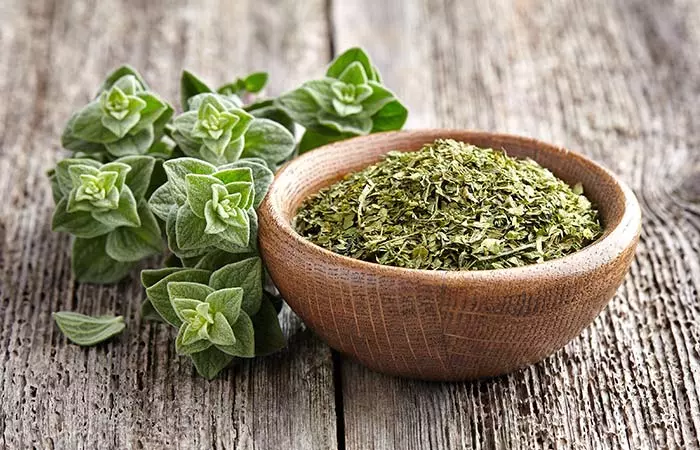
Strictly speaking, oregano is more of a flavor than an herb. Approximately 60 plant species that share a similar flavor and color are often labeled ‘oregano’ (1).
This flavor is primarily derived from several species of Origanum and Lippia plants. The Origanum species is native to parts of Europe, Asia, and the Mediterranean countries. The Lippia species can be found in Mexico (2).
Traditional Chinese and European medicine used oregano to heal cough, asthma, diarrhea, stomach ache, and menstrual inflammatory disorders. It is said that the Greeks used oregano creams on sores and aching muscles (1), (3).
Therefore, oregano is widely used in present-day Mediterranean cuisine. The bioactive ingredientsi Compounds found in certain foods and plants researched for their potential to prevent cancer, heart disease, and other illnesses. in these plants give them antioxidant, anti-inflammatory, and antimicrobial properties. These herbs are used as a natural flavoring agent and preservative in several foods.
After learning about what is oregano, let’s take a look at the wide varieties of oregano. Based on its origin and biochemical composition, oregano is classified into several varieties that are sold under different names.
Key Takeaways
- Oregano is a powerhouse of antioxidants that can help relieve inflammation due to common problems like menstrual cramps and toothache.
- The antimicrobial properties in oregano help remove toxins from the body and tackle excess free radicals.
- Oregano carries antiviral properties that can aid in treating the common cold and sore throats.
- Oregano is known for stimulating menstruation, hence pregnant women should refrain from consuming it in large amounts.
What Are The Different Types Of Oregano?
The two major varieties of oregano are European and Greek.
European oregano (also known as wild marjoram or winter marjoram) is derived from Origanum vulgare. Greek oregano (also known as sweet marjoram or pot marjoram) is derived from Origanum heracleoticum (2).
Another popular variety is the Mexican oregano. It is derived from Lippia graveolens and commonly known as Mexican sage, Mexican marjoram, or Mexican wild sage (2).
European oregano is primarily produced in Greece, Italy, Spain, Turkey, and the United States. And Mexican oregano is (obviously!) native to Mexico.
All the oregano varieties are rich in essential oils. These oils contain bioactive ingredients that give the spice its flavor and medicinal properties.
Hence, European and Greek oregano variants are known to possess digestive, stimulant, and disinfectant properties.
In the section coming up, you will find out how oregano benefits your health, along with scientific evidence. Keep scrolling!
How Does Oregano Benefit Your Health?
With its abundant flavonoids and phenolic acidsi Compounds absorbed through the intestine that can reduce inflammation and act as antioxidants, protecting cells from free radical damage. , oregano is a potent antioxidant and anti-inflammatory agent. It relieves menstrual discomfort, muscular pain, and respiratory diseases.
1. Relieves Pain And Inflammation
Nitric oxide, prostaglandins, and free radicals are common pro-inflammatory factors that your body produces. Fresh and dried oregano extracts have been proven to control the production of such compounds (4).
Caffeic acid, chlorogenic acid, quercetin, luteolin, and their derivatives in oregano play an active role in reducing pain and inflammation and improving cardiovascular health. Carvacrol, a major component in its essential oil, can heal wounds, cuts, gastric ulcers, and cancers (4), (5).
Therefore, oregano may help relieve inflammatory disorders like rheumatoid arthritis, menstrual cramps, muscle pain, toothache, and insect bites. You can also make oregano-based topical formulas – like cream, lotion, or diluted oil – for external use (6).
2. Treats Microbial Infections
Oregano essential oil has potent antimicrobial activity. Carvacrol and thymol – its active components – are responsible for this effect. They alter the permeability of bacterial and fungal cells. This leads to a leakage of their cellular contents, leading to their death (7), (8).
Another mechanism oregano employs is releasing free radicals. Your body releases these reactive molecules to destroy these pathogens. This mechanism takes place primarily in your gut. However, these free radicals are toxic to your body (8).
Since oregano and its oil are rich in antioxidants, consuming either of them eliminates these toxins from your system and maintains immunity (8). Thus, this spice doubles up as a food preservative as well as an antimicrobial agent (7), (8).
 Trivia
Trivia3. Clears Dandruff And Scalp Issues

Oregano leaves are reservoirs of essential oil. There are many Oregano essential oil benefits. Among these, the most notable ones are treating dandruff and soothing itchy scalp. The use of oregano leaf extracts on hair and scalp has shown significant effects in some studies, with subjects experiencing a remarkable reduction in dandruff within just 7 days of treatment (9).
Oregano oils have antifungal activity. Their components can kill fungi belonging to Penicillium and Fusarium species. You can make a cheaper anti-dandruff shampoo or an oil using oregano leaves (9).
The carvacrol and thymol found in them are responsible for this property. Add coconut oil, camphor, hibiscus leaves/flowers, and oregano leaves to these preparations to prevent microbial scalp infections and maintain healthy hair (9).
4. A Potent Antioxidant
Oregano has phenolic compounds and vitamins that inhibit the formation and accumulation of free radicals. Water-based extracts of this spice can eliminate up to 70% superoxide (harmful) ions (10), (11).
They also chemically trap (chelate) metal ions, like iron. An excess of these metal ions has deleterious effects on your metabolism.
Chemical analyses revealed the presence of vitamin E (tocopherol derivatives) in oregano leaves. These active molecules inhibit lipid peroxidationi A metabolic process that damages lipids (fats) in cells via unstable molecules, resulting in cell damage and death. . This may stop inflammation in the vital organs, ultimately protecting you from obesity, atherosclerosis, diabetes, and Alzheimers’s disease (11), (12).
5. May Treat Skin Diseases

The anti-inflammatory and antimicrobial property of oregano aids in wound healing. Some studies claim that this spice can treat psoriasis, eczema, rashes, and several skin conditions. However, there is insufficient evidence to prove this application (9).
Oregano oil is known for its antiseptic properties. Topical use of creams, ointments, and lotions containing this oil may relieve skin infection and inflammation (13).
It can also repair and remodel damaged tissues. With further research and trials, oregano extracts could be used in skin care products for children and adults (5).
6. Treats Flu And Viral Diseases
The carvacrol in oregano extracts demonstrates antiviral properties. Clinical studies report that this active molecule directly targets the RNA (genetic material) of certain viruses. This impairs their process of infecting a human host cell (14).
One of the most common and frequent viral infections we experience is the common cold. Ingesting oregano during a flu bout can reduce the severity of cough, sore throat, and fever. Having freshly brewed, hot oregano tea works the best in this case (15), (16).
Mexican oregano oil could inhibit other human viruses like HIV and Rotavirusi A highly contagious virus that can result in diarrhea and is usually treated at home with increased hydration. . Further research is needed to establish its antiviral effects on herpes simplex virus (HSV), hepatitis viruses, and human respiratory viruses (17).
Did You Know?
The word ‘oregano’ in Greek means ‘joy of the mountain.’
Greeks believed that cows that grazed in oregano fields produce tastier meat.
The active molecules in oregano leaves – like carvacrol and thymol – are responsible for these benefits. But, it is not just these two compounds. This spice has a rich nutritional profile containing polyphenols and micronutrients.
Like oregano spice, oregano tea benefits health in many ways. You can learn about them in the section below.
Oregano Tea Benefits
1.Protects From Oxidative Stress
Oregano tea is rich in antioxidants that protect the cells from oxidative damage and prevent mutagenesis, aging, and carcinogenesis (18). It may also help prevent cardiovascular diseases and neurodegenerative disorders.
2. May Boost Immunity
Oregano tea may effectively boost immune function if included in a diet. This tea has decent amounts of vitamin C that may help boost immune function (19).
3. May Help Manage Stress
Oregano tea exhibits a calming effect that may help reduce anxiety and stress. Animal studies have shown that administration of oregano extract may reduce stress and anxiety like behavior (20).
Scroll down to know more about its full nutritional profile.
Phytonutritional Profile Of Oregano
| OREGANO (Dried leaves) | ||
|---|---|---|
| Nutrient | Unit | 1 tsp, leaves = 1.0g |
| Proximates | ||
| Water | g | 0.1 |
| Energy | kcal | 3 |
| Energy | kJ | 11 |
| Protein | g | 0.09 |
| Total lipid (fat) | g | 0.04 |
| Ash | g | 0.08 |
| Carbohydrate, by difference | g | 0.69 |
| Fiber, total dietary | g | 0.4 |
| Sugars, total | g | 0.04 |
| Sucrose | g | 0.01 |
| Glucose (dextrose) | g | 0.02 |
| Fructose | g | 0.01 |
| Minerals | ||
| Calcium, Ca | mg | 16 |
| Iron, Fe | mg | 0.37 |
| Magnesium, Mg | mg | 3 |
| Phosphorus, P | mg | 1 |
| Potassium, K | mg | 13 |
| Sodium, Na | mg | 0 |
| Zinc, Zn | mg | 0.03 |
| Copper, Cu | mg | 0.006 |
| Manganese, Mn | mg | 0.05 |
| Vitamins | ||
| Vitamin C, total ascorbic acid | mg | 0 |
| Thiamin | mg | 0.002 |
| Riboflavin | mg | 0.005 |
| Niacin | mg | 0.046 |
| Pantothenic acid | mg | 0.009 |
| Vitamin B-6 | mg | 0.01 |
| Folate, total | µg | 2 |
| Folate, food | µg | 2 |
| Folate, DFE | µg | 2 |
| Choline, total | mg | 0.3 |
| Betaine | mg | 0.1 |
| Vitamin A, RAE | µg | 1 |
| Carotene, beta | µg | 10 |
| Vitamin A, IU | IU | 17 |
| Lutein + zeaxanthin | µg | 19 |
| Vitamin E (alpha-tocopherol) | mg | 0.18 |
| Tocopherol, gamma | mg | 0.24 |
| Tocopherol, delta | mg | 0.01 |
| Vitamin K (phylloquinone) | µg | 6.2 |
Source: USDA
Different varieties of oregano have different concentrations of phenolic compounds. The commonly found classes are phenolic acids, esters and its glycosides, flavonoidsi Plant compounds that work as antioxidants and anti-inflammatories that may aid in preventing cancer and neurodegeneration. , and steroids (21).
Phenolic acids include rosmarinic acid, caffeic acid, protocatechuic acid, and lithospermic acid (21).
Terpenoidsi A broad class of organic compounds that produce aromas, flavors, and colors, usually in plants and, in certain cases, in animals. /terpenes like sabinene, 1,8-cineole, cymene, cadinene, ocimene, caryophyllene, germacrene D, limonene, bisabolene, linalool, spathulenol, carvacrol, and thymol were also identified in oregano (20) (21).
Flavonoids – including apigenin, luteolin, chrysoeriol, diosmetin, quercetin, eriodictyol, cosmocide, and vicenin-2 – are also abundant in these leaves (21).
Since it has such a potent and loaded biochemical profile, oregano has been classified as a spice. No wonder it is integral to so many global and local cuisines!
Don’t you also want to know how to use it in cooking? Read the next section to find out how!
How To Use Oregano in Cooking
Fresh
oregano can be used towards the end – like a cilantro garnish. Dried leaves should be added in the beginning so that the heat releases all its flavors.
You can use fresh/dried oregano in the following ways:
- Sprinkle it as a topping on pizzas, salads, soups, and
- Use it to flavor omelets, frittatas, and sautéed vegetables (stir-fry).
- Marinate meat and chicken with fresh, chopped oregano and other spices.
- Add it as a finishing touch to home-made garlic bread.
- Put a few sprigs of fresh oregano in a container with olive oil. Oregano-olive oil infusion is ready! You can cook, dress salads, and also apply it as a topical antiseptic/moisturizing agent.
- Vinaigrettes with oregano add great depth to Italian dishes.
Always add oregano at the end of the cooking process to keep its flavor fresh. Add a little of it first and then more if needed, as too much oregano can make your meal bitter.
Aimee Schrank, a blogger shares the benefits of oregano oil, highlighting its potency and versatile applications. She says, “So far we have been using it to aid in fighting viruses and other illnesses, as well as an immune stimulant. Up until today the only way I have used it was applying topically on the soles of our feet.” She further adds, “I love using oregano oil in cooking as well (i).”
 Quick Tip
Quick TipHere’s a quick and delicious recipe using oregano. Why don’t you give it a shot right away?
Sizzling Barbeque Chicken – Italian style

What You Need
- Lemon juice: 1 cup
- Vegetable/olive oil: ¼-½ cup
- Vinegar: ¼ cup
- Dried oregano: 1 tablespoon
- Garlic powder: 2 teaspoons
- Whole chicken: 1, cut into pieces
- Salt: to taste
- Pepper: to taste
- Mixing bowl: large sized
- Outdoor grill or similar grilling equipment
Let’s Make It!
- To a large mixing bowl, add lemon juice, vegetable oil, vinegar, oregano, and garlic powder. Mix the contents well. (If you manage to get fresh oregano leaves, finely chop them before adding.)
- Add the chicken pieces to the mixture.
- Season with salt and pepper.
- Toss the pieces in the marinade thoroughly to coat evenly.
- Cover and marinate in the refrigerator for at least 1 hour.(Overnight marination will give best results)
- Preheat an outdoor grill on high heat/temperature. Grease the grill grates lightly.
- When the grill is prepared, carefully place the marinated chicken pieces on the grates.
- Brush the chicken periodically with the remaining marinade while cooking.
- Cook the chicken until no longer pink and juices run clear.
- Transfer the cooked pieces to a serving dish.
- Enjoy this Italian style barbeque chicken with rice or by itself with dips of your choice.
Ta-da!
Just reading this made my stomach growl with hunger! This recipe will leave you craving more – thanks to the zest and punch that oregano packs.
As it adds a blast of flavor to your food, it is best to stock some oregano in your pantry.
Before heading out to buy some, read the next section. The tips may come in handy.
How To Pick And Store The Best Oregano

- Choose fresh oregano over the dried form. It has a deeper flavor.
- The leaves of fresh oregano should look bright and vibrant green. The stems should be firm.
- Discard the ones with dark spots or yellowing.
- When purchasing dried oregano, try to pick the one labeled ‘organically ’ These products are free from irradiation, pesticide, etc.
- To store fresh oregano, wrap the bunch in a damp paper towel and place it in the refrigerator.
- You can also freeze the leaves – whole or chopped – in airtight
- Another interesting way to freeze oregano is in ice cube trays. Place fresh oregano leaves in each of the cubes. Fill them with either water or stock and freeze. Use these frozen oregano cubes when preparing soups or stews.
- Store dried oregano in a tightly sealed glass container in a cool, dark, dry place. It keeps for about 6months when stored this way.
How To Dry Fresh Oregano Leaves
- Pull off the tiny leaves from fresh oregano stalks and air-dry them separately.
- Or, dry the entire stem, then crumble off the crisp leaves. You will need to hang bundles of these stems and leave them to dry for about two weeks. Loosely wrap a paper bag around these bundles to collect the leaves as they fall.
- For those looking to quick-dry oregano, use a microwave oven or a food dehydrator. Flip the stems/leaves periodically to expose both their sides to air and heat.
- Dried stalk remnants can go into the brick oven, grill, or smoker. Meat cooked on them will catch the mild herbaceous scent from these stalks.
With its excellent shelf life and storage options, oregano is here to stay!
But, is it healthy to eat oregano frequently? Is there an intake limit and are there any side effects linked to this herb? Scroll down to find out.
How Much Oregano Is Safe To Eat? Are There Any Side Effects Of Eating Oregano?
Oregano and its oil are likely safe when taken orally in food.
When taken by itself in medicinal amounts as a supplement, it is possibly safe. But the evidence is insufficient to prove its effectiveness (22).
However, oregano is a potent emmenagoguei A specific substance/herb that increases blood flow to the uterus to trigger menstruation, which is otherwise hindered by hormonal changes. . It stimulates menstruation and uterine contractions (abortifacient). Hence, pregnant women and new mothers should avoid consuming it in high amounts (22).
If you are allergic to herbs like basil, mint, sage, or lavender, you may be allergic to oregano too. Watch how your body reacts to it (22).
An overdose of this herb may cause stomach ache and digestive issues. Also, applying concentrated or oxidized oregano based oils or creams may induce irritation. Though these side effects have not been proven yet, it is better to be safe than sorry (23).
Infographic: Must-Know Benefits And Side Effects Of Oregano
Oregano has so much more to offer apart from just being a food seasoning. It provides many benefits for your hair, skin, and health. This herb packs a healthy punch, from preventing infections to treating dandruff. But it also has a flip side you should know about. Check out the infographic below to learn about its health benefits and side effects.
Some thing wrong with infographic shortcode. please verify shortcode syntaxOregano is an herb that adds flavor to foods. The many benefits of oregano can be attributed to its rich polyphenolic and phytonutrient compounds. This spicy herb is available in different types and possesses antioxidant, antimicrobial, and anti-inflammatory properties. It helps relieve pain, reduces symptoms of anxiety and depression, and inflammation. It also helps treat microbial infections, clears dandruff and scalp issues, treats eczema, rashes, and psoriasis, relieves skin infection and inflammation, and treats flu and viral diseases. However, an overdose of oregano may cause stomach aches and issues with digestion. Hence, consult your doctor first regarding the ideal dosage. Also, avoid intake of this herb during pregnancy as it stimulates menstruation and uterine contractions.
Frequently Asked Questions
Can oregano be taken daily?
Organo can be taken daily in moderation to reap its maximum benefits.
Is oregano good for the lungs?
Carvacrol and terpenes in oregano may help cleanse the lungs.
How long does oregano take to work?
Oregano may take 20 minutes (in case of cough) to work.
Is oregano tea good for sleeping?
Yes. Oregano tea is considered an excellent aid for sleeping.
Can I eat raw oregano leaves?
Raw oregano leaves could be too pungent to eat. While eating them doesn’t seem to cause harm, practice caution.
Illustration: Oregano: Health Benefits, Uses, And Side Effects

Image: Stable Diffusion/StyleCraze Design Team
Explore the incredible world of oregano leaves and discover their numerous health benefits. Watch this video to learn ways to incorporate this versatile herb into your culinary and medicinal endeavors.
Personal Experience: Source
StyleCraze's articles are interwoven with authentic personal narratives that provide depth and resonance to our content. Below are the sources of the personal accounts referenced in this article.
i. Meet Oregano, My Miracle Oilhttps://terratribeessentialsolutions.wordpress.com/2015/04/25/meet-oregano-my-miracle-oil/
References
Articles on StyleCraze are backed by verified information from peer-reviewed and academic research papers, reputed organizations, research institutions, and medical associations to ensure accuracy and relevance. Read our editorial policy to learn more.
- Oregano (Origanum vulgare) extract for food preservation and improvement in gastrointestinal health, Author manuscript, HHS Public Access, US National Library of Medicine
https://www.ncbi.nlm.nih.gov/pmc/articles/PMC6508890/ - OREGANO, NewCROP, Center for New Crops & Plant Products, Purdue University
https://www.hort.purdue.edu/newcrop/med-aro/factsheets/OREGANO.html - Oregano: Overview of the Literature on Health Benefit, Nutrition Today, ResearchGate
https://www.researchgate.net/publication/232240488_Oregano_Overview_of_the_Literature_on_Health_Benefits - Flavonoids and Phenolic Acids from Oregano: Occurrence, Biological Activity and Health Benefits, Plants, US National Library of Medicine
https://www.ncbi.nlm.nih.gov/pmc/articles/PMC5874591/ - Anti-inflammatory, tissue remodeling, immunomodulatory, and anticancer activities of oregano (Origanum vulgare) essential oil in a human skin disease model, Elsevier Biochimie Open, US National Library of Medicine
https://www.ncbi.nlm.nih.gov/pmc/articles/PMC5801825/ - Oregano: a Wonder Herb, Journal of Pharmaceutical Sciences and Research, US National Library of Medicine
https://citeseerx.ist.psu.edu/viewdoc/download?doi=10.1.1.637.9988&rep=rep1&type=pdf - Antimicrobial activity of essential oils of cultivated oregano (Origanum vulgare), sage (Salvia officinalis), and thyme (Thymus vulgaris) against clinical isolates of Escherichia coli, Klebsiella oxytoca, and Klebsiella pneumoniae, Microbial Ecology in Health and Disease, US National Library of Medicine
https://www.ncbi.nlm.nih.gov/pmc/articles/PMC4400296/ - Antibacterial and antioxidant activity of oregano essential oil, Iowa State University, digital Repository, Iowa State University
https://dr.lib.iastate.edu/handle/20.500.12876/84049/ - EXTRACTED OIL FROM OREGANO (OREGANUM VULGARE) AS MAIN COMPONENT FOR ANTI-DANDRUFF SHAMPOO, Academia
https://www.academia.edu/34838356/EXTRACTED_OIL_FROM_OREGANO_OREGANUM_VULGARE_AS_MAIN_COMPONENT_FOR_ANTI_DANDRUFF_SHAMPOO - ANTIOXIDANT PROPERTIES OF OREGANO (ORIGANUM VULGARE) LEAF EXTRACTS, Journal of Food Biochemistry, Food & Nutrition Press, Inc., Academia
https://www.academia.edu/7797910/ANTIOXIDANT_PROPERTIES_OF_OREGANO_ORIGANUM_VULGARE_LEAF_EXTRACTS - Nutrient antioxidants in oregano. International Journal of Food Sciences and Nutrition, US National Library of Medicine
https://pubmed.ncbi.nlm.nih.gov/8933203/ - Oregano Essential Oil as an Antimicrobial and Antioxidant Additive in Food Products. Critical Reviews in Food Science and Nutrition, US National Library of Medicine
https://pubmed.ncbi.nlm.nih.gov/25763467/ - An Up-To-Date Review Regarding Cutaneous Benefits of Origanum vulgare L. Essential Oil, US National Library of Medicine.
https://pmc.ncbi.nlm.nih.gov/articles/PMC9137521/ - Antiviral efficacy and mechanisms of action of oregano essential oil and its primary component carvacrol against murine norovirus. Journal of Applied Microbiology, US National Library of Medicine
https://pubmed.ncbi.nlm.nih.gov/24779581/ - Complementary Treatment of the Common Cold and Flu with Medicinal Plants – Results from Two Samples of Pharmacy Customers in Estonia, PLoS One, US National Library of Medicine
https://www.ncbi.nlm.nih.gov/pmc/articles/PMC3590151/ - OREGANO (ORIGANUM VULGARE), Heritage Garden, University of Illinois at Chicago
http://heritagegarden.uic.edu/oregano-origanum-vulgare - Antiviral activity of the Lippia graveolens (Mexican oregano) essential oil and its main compound carvacrol against human and animal viruses, Brazilian Journal of Microbiology, US National Library of Medicine
https://www.ncbi.nlm.nih.gov/pmc/articles/PMC3768712/ - Antioxidant, Antibacterial, and Cytotoxic Activities of the Ethanolic Origanum vulgare Extract and Its Major Constituents
https://www.ncbi.nlm.nih.gov/pmc/articles/PMC4804097/ - Vitamin C and Immune Function
https://pubmed.ncbi.nlm.nih.gov/29099763/ - A behavioral and molecular study; ameliorated anxiety-like behavior and cognitive dysfunction in a rat model of chronic unpredictable stress treated with oregano extract
https://pubmed.ncbi.nlm.nih.gov/29099763/ - Chemical constituents and biological studies of Origanum vulgare Pharmacognosy Research, US National Library of Research
https://www.ncbi.nlm.nih.gov/pmc/articles/PMC3129025/ - Herbs, Pediatric Pulmonary Division, UFHealth, University of Florida
https://pulmonary.pediatrics.med.ufl.edu/files/2013/08/Herbs.pdf - Essential Oils of Oregano: Biological Activity beyond Their Antimicrobial Properties, Molecules, US National Library of Medicine
https://www.ncbi.nlm.nih.gov/pmc/articles/PMC6152729/
Read full bio of Vd. Naveen Sharma
Read full bio of Swathi Handoo
Read full bio of Ravi Teja Tadimalla
Read full bio of Aparna Mallampalli












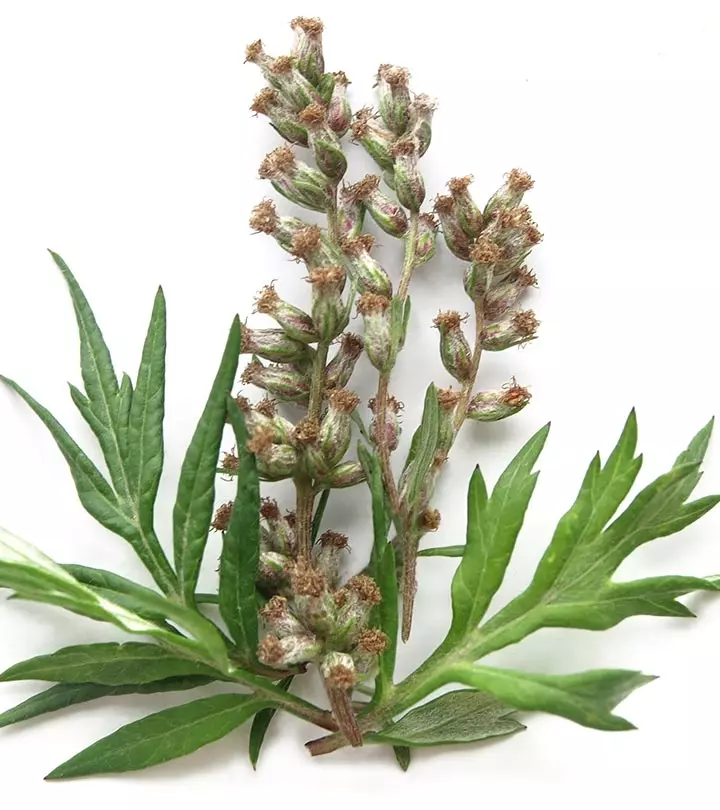


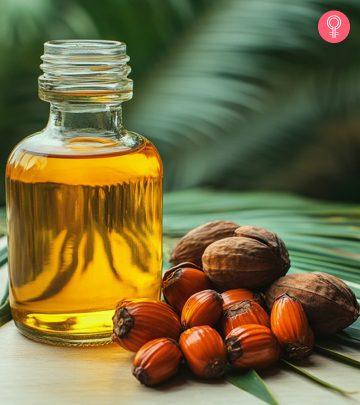








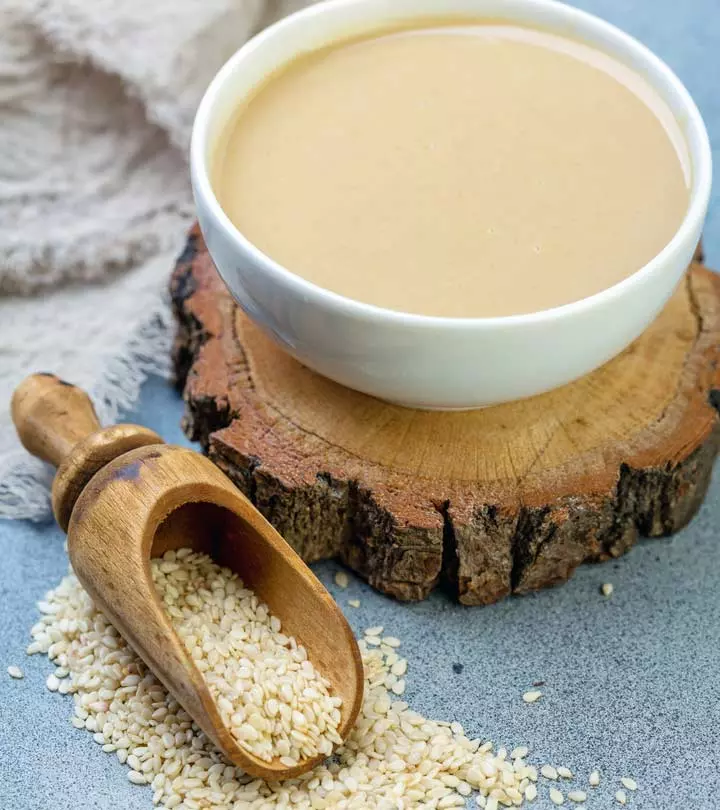

Community Experiences
Join the conversation and become a part of our empowering community! Share your stories, experiences, and insights to connect with other beauty, lifestyle, and health enthusiasts.